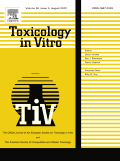
TOXICOLOGY IN VITRO
Scope & Guideline
Fostering Global Collaboration in Toxicological Research
Introduction
Aims and Scopes
- In Vitro Toxicity Assessment:
The journal emphasizes the use of in vitro models to assess the cytotoxic and genotoxic effects of various chemicals, including pharmaceuticals, environmental pollutants, and food additives, thereby promoting alternative testing methods. - Mechanistic Studies:
Research often focuses on elucidating the mechanisms of toxicity at the cellular and molecular levels, including studies on oxidative stress, apoptosis, and the role of specific signaling pathways in mediating toxic effects. - Development of New Methodologies:
The journal encourages contributions that introduce novel in vitro techniques or modifications to existing methods, such as high-throughput screening, 3D cell cultures, and organ-on-a-chip technologies. - Pharmacokinetics and Toxicokinetics:
Papers frequently explore the absorption, distribution, metabolism, and excretion of chemicals using in vitro models, facilitating a better understanding of how substances interact with biological systems. - Regulatory Science and Risk Assessment:
The journal addresses the integration of in vitro data into regulatory frameworks and risk assessment processes, providing insights that can influence policy and guidelines for chemical safety.
Trending and Emerging
- Nanotoxicology:
There is a growing body of work focused on the toxicity of nanoparticles and nanomaterials, exploring their interactions with biological systems and potential health risks, which is increasingly relevant given the rise of nanotechnology. - Microplastics and Environmental Pollutants:
Research on the toxicological effects of microplastics and associated environmental pollutants has surged, highlighting concerns about their widespread presence and impact on health. - 3D and Organ-on-a-Chip Models:
Increasing interest in three-dimensional cell cultures and organ-on-a-chip technologies is evident, with studies emphasizing their advantages in mimicking physiological conditions more accurately than traditional models. - Biomarkers and Molecular Mechanisms:
There is an emerging trend towards identifying specific biomarkers of toxicity and elucidating molecular mechanisms, which aids in the development of targeted interventions and risk assessments. - Integrative Approaches in Toxicology:
The integration of omics technologies (genomics, proteomics, metabolomics) with in vitro studies is gaining traction, providing comprehensive insights into the biological effects of toxicants.
Declining or Waning
- Traditional Animal Models:
As the journal promotes in vitro methods, traditional animal testing approaches are becoming less frequently discussed, reflecting a broader trend towards reducing animal use in research. - General Toxicity Testing without Mechanistic Insights:
There is a noticeable decrease in studies that report general toxicity findings without delving into the mechanistic aspects, as the emphasis shifts towards understanding specific pathways and molecular interactions. - Single Cell Type Studies:
Research focusing solely on single cell type models is waning, with a growing preference for complex multicellular systems that better mimic in vivo environments. - Static Culture Systems:
Static two-dimensional culture systems are being replaced by more advanced models such as three-dimensional cultures and organoids, leading to a decline in publications centered around traditional static methods.
Similar Journals

TOXICOLOGY AND APPLIED PHARMACOLOGY
Unraveling the Complexities of Drug InteractionsTOXICOLOGY AND APPLIED PHARMACOLOGY, published by Academic Press, Inc. Elsevier Science, stands as a leading journal in the domains of toxicology and pharmacology, with its establishment dating back to 1959. With an impact factor reflecting its academic rigor and relevance, this journal is classified in the Q2 quartile for both pharmacology and toxicology categories, underscoring its significance in the scientific community. It ranks #34 out of 133 in Toxicology and #95 out of 313 in Pharmacology according to Scopus, placing it within the 74th and 69th percentiles, respectively. The journal aims to disseminate quality research that drives advancements in understanding the interactions of drugs and toxic substances within biological systems. Researchers and professionals are invited to contribute and engage with a broad spectrum of articles that cover mechanistic studies, risk assessment, and innovative therapeutic strategies. Although the journal does not offer open access, it continues to be a crucial resource for those who seek to navigate the complex interface of drugs and their toxicological implications.

TOXICOLOGY
Advancing toxicological insights for a safer tomorrow.TOXICOLOGY, published by Elsevier Ireland Ltd, is a prestigious peer-reviewed journal specializing in the field of toxicology. With an ISSN of 0300-483X and an E-ISSN of 1879-3185, this journal provides a vital platform for researchers, professionals, and students to disseminate and access groundbreaking studies from 1973 to present, with a convergence set until 2024. Recognized for its high impact, it holds a Q1 ranking in Toxicology category and ranks #18 out of 133 in Scopus's sector of Pharmacology, Toxicology, and Pharmaceutics, placing it in the 86th percentile. While the journal is not open access, it nonetheless offers a rich collection of research articles that enhance the understanding of toxicological science and its applications. The journal's objectives encompass advancing knowledge in the toxicological evaluation of substances, promoting safety in public health, and fostering dialogue among scholars. As a key resource in the field, TOXICOLOGY plays a crucial role in advancing research and informing practices related to toxicological risks and safety assessments.

Bangladesh Journal of Pharmacology
Fostering Global Collaboration in Pharmaceutical SciencesThe Bangladesh Journal of Pharmacology, published by the Bangladesh Pharmacological Society, is a leading platform dedicated to advancing knowledge in the field of pharmacology. With an ISSN of 1991-007X and an E-ISSN of 1991-0088, this open access journal has been making significant contributions to the field since its inception in 2006. Located at the Bangabandhu Sheikh Mujib Medical University in Dhaka, Bangladesh, the journal provides a vital resource for researchers, professionals, and students interested in pharmacology, toxicology, and pharmaceutics. As of 2023, the journal is categorized in the Q4 quartile for pharmacology, ranking 240th out of 313 in Scopus and falling within the 23rd percentile, reflecting its commitment to the dissemination of high-quality research. The journal encompasses a diverse array of topics from basic research to clinical applications, aiming to foster a deeper understanding of pharmacological principles and practices. By providing open access to its content, the Bangladesh Journal of Pharmacology ensures that valuable scientific findings are readily available to the global community, supporting the advancement of medical and pharmaceutical sciences.
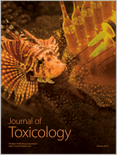
Journal of Toxicology
Empowering global research in toxicological science.Journal of Toxicology, published by HINDAWI LTD, stands as a pivotal open-access journal in the fields of toxicology and pharmacology since its inception in 2009. With an ISSN of 1687-8191 and an E-ISSN of 1687-8205, this journal is dedicated to disseminating high-quality research that critically examines the effects of toxic substances on living organisms. Located in Egypt and operating from their London office, it aims to provide an extensive platform for researchers worldwide to share findings that can inform better practices in safety and regulation. As of 2023, it has achieved significant recognition, holding a Q3 ranking in both the pharmacology and toxicology categories, and is indexed in Scopus with noteworthy percentile rankings (Toxicology: 57th and Pharmacology: 55th). With a focus on innovative studies and emerging areas such as environmental toxicology, biomarker research, and therapeutic interventions, the Journal of Toxicology invites both experienced researchers and students to contribute, thereby enhancing the breadth and depth of toxicological knowledge for the global scientific community.
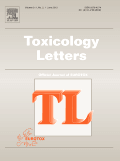
TOXICOLOGY LETTERS
Fostering collaboration to combat chemical hazards.TOXICOLOGY LETTERS is a prominent journal dedicated to advancing the field of toxicology, providing a platform for high-quality research and reviews that explore the effects of chemical substances on biological systems. Published by Elsevier Ireland Ltd, this peer-reviewed journal has established itself as a vital resource in toxicological research since its inception in 1977, with a convergence of studies extending to 2024. With an impressive Scopus ranking, positioned at #28 out of 133 in the Toxicology category, TOXICOLOGY LETTERS garners a respectable percentile of 79, highlighting its significance in the academic community. Although it is not an open-access journal, its research is accessible through institutional subscriptions, ensuring that critical insights into human health and environmental safety are disseminated effectively. Being categorized in the Q2 quartile in both Medicine (miscellaneous) and Toxicology for 2023 further emphasizes its relevance and impact in these fields. This journal aims to foster collaboration between researchers and professionals, encouraging the exploration of innovative solutions to chemical hazards and the promotion of safer practices in pharmacology and toxicology.
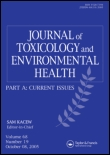
JOURNAL OF TOXICOLOGY AND ENVIRONMENTAL HEALTH-PART A-CURRENT ISSUES
Illuminating Critical Issues in Environmental ToxicologyJOURNAL OF TOXICOLOGY AND ENVIRONMENTAL HEALTH-PART A-CURRENT ISSUES, published by Taylor & Francis Inc, stands as a key resource in the interdisciplinary field of toxicology and environmental health. Operating under the ISSN 1528-7394 and E-ISSN 1087-2620, this journal maintains a strong presence with a Q2 category ranking in Health, Toxicology and Mutagenesis and a Q3 ranking in Toxicology as of 2023. It aims to disseminate critical findings that address contemporary issues in toxicology and environmental health, emphasizing the implications of environmental agents on human health. The journal offers both subscription and open access options, making cutting-edge research accessible to a diverse readership. With coverage of key topics from 1998 to 2024, it is an essential platform for academics, professionals, and students seeking to stay at the forefront of environmental health sciences.

Frontiers in Toxicology
Unveiling the Complexities of Pharmacological ImpactsFrontiers in Toxicology, published by Frontiers Media SA, is a prominent open-access journal dedicated to advancing the understanding of toxicological science. Established in 2019, it serves as a vital forum for innovative research, offering insights into the pharmacological impacts and toxicological profiles of various substances. With its international reach based in Switzerland, this journal has quickly ascended in the academic community, achieving a notable Q1 ranking in Pharmacology, Toxicology and Pharmaceutics (Miscellaneous) and a Q2 ranking in Toxicology as of 2023. The journal is indexed in Scopus, where it ranks #8 out of 43 in its primary category, underscoring its influence and relevance in the field. The scope encompasses cutting-edge studies on the mechanisms of toxicity, including both human and environmental impacts, making it an essential resource for researchers, professionals, and students alike. By promoting open access to high-quality research, Frontiers in Toxicology plays a crucial role in enhancing knowledge sharing and fostering collaboration across disciplines.

Current Research in Toxicology
Innovative Research for Real-World ApplicationsCurrent Research in Toxicology is a pioneering journal published by ELSEVIER that serves as a vital platform for disseminating cutting-edge research in the field of toxicology, spanning from biological impacts to pharmacological applications. With an ISSN of 2666-027X and an impressive Q2 ranking in key categories such as Applied Microbiology and Biotechnology, Health, Toxicology and Mutagenesis, and Toxicology, this journal underscores its commitment to high-quality research and significant contributions to the scientific community. Based in the Netherlands, Current Research in Toxicology aims to bridge the gap between academia and industry by providing rigorously peer-reviewed articles that cover a wide array of topics including novel methodologies, regulatory challenges, and emerging trends within the domain. The journal is accessible through various platforms, making it essential for researchers, professionals, and students eager to stay updated on the latest findings and advancements in toxicology. With a comprehensive focus on integrating theory with practical application, this journal is poised to influence future studies and policies in health and environmental science.
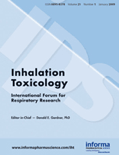
INHALATION TOXICOLOGY
Innovating Understanding of Toxic Responses to Inhalants.Inhalation Toxicology, published by Taylor & Francis Ltd, is a premier journal dedicated to advancing the field of toxicology with a particular focus on inhalation exposure and its impact on human health. Established in 1989, this journal provides a vital platform for original research, reviews, and case studies that explore the toxicological effects of inhaled substances, making it essential reading for researchers, health professionals, and regulatory scientists. With an Impact Factor that situates it in the Q3 category in both Health, Toxicology and Mutagenesis, the journal asserts its relevance within the scientific community, particularly emphasizing its contributions as indexed by Scopus rankings in related fields. Although it follows a traditional access model, the journal's commitment to delivering high-quality research continues to foster significant discussions and advancements in understanding inhalation toxicology. For those at the forefront of environmental science and pharmacology, Inhalation Toxicology is an indispensable resource for both current research and future innovations in the discipline.

IN VITRO CELLULAR & DEVELOPMENTAL BIOLOGY-ANIMAL
Exploring the Depths of In Vitro DevelopmentIN VITRO CELLULAR & DEVELOPMENTAL BIOLOGY-ANIMAL, published by SPRINGER, is a pivotal journal in the fields of cell biology and developmental biology, focusing on in vitro studies that enhance our understanding of animal cellular mechanisms and development. With an ISSN of 1071-2690 and an E-ISSN of 1543-706X, this esteemed journal offers a platform for researchers to present their findings and contribute to the body of knowledge necessary for advancements in biological sciences. As a recognized publication, it holds a 2023 category quartile of Q4 in Cell Biology and Developmental Biology, and Q3 in miscellaneous Medicine, reflecting its competitive position yet inviting critical submissions that can span multidisciplinary approaches. Though currently not open access, it serves as an essential resource for professionals, researchers, and students dedicated to unraveling the complexities of cellular processes in an ever-evolving field. The journal has been continuously published since 1986, signifying its long-standing commitment to fostering scientific discourse and innovation.